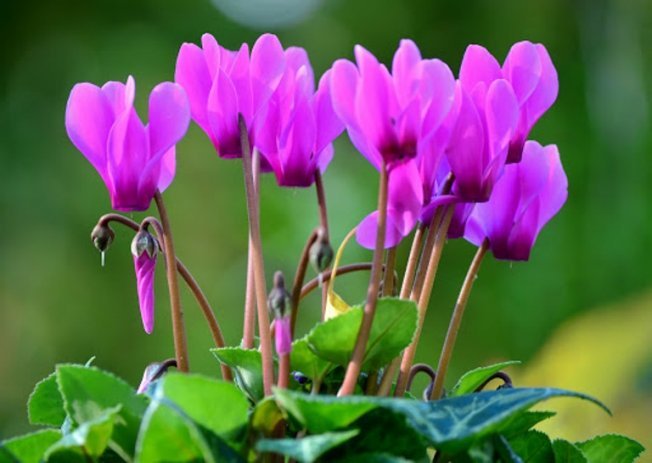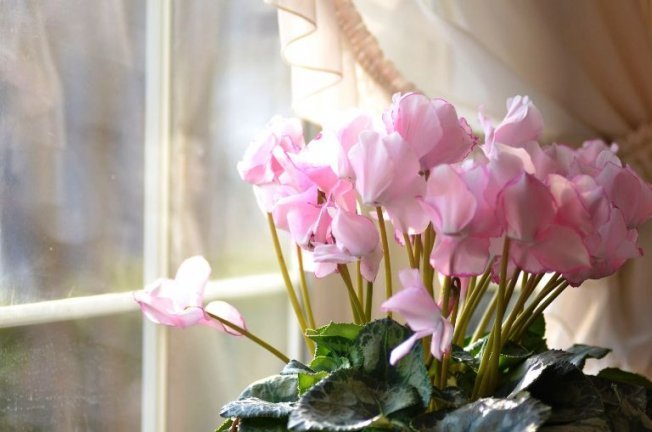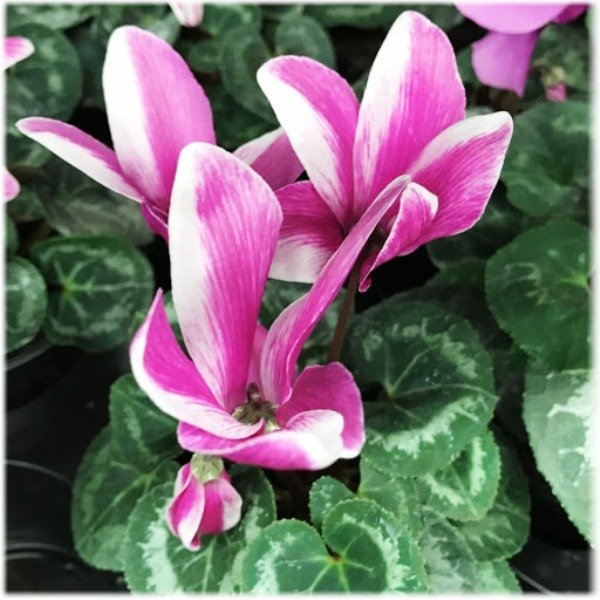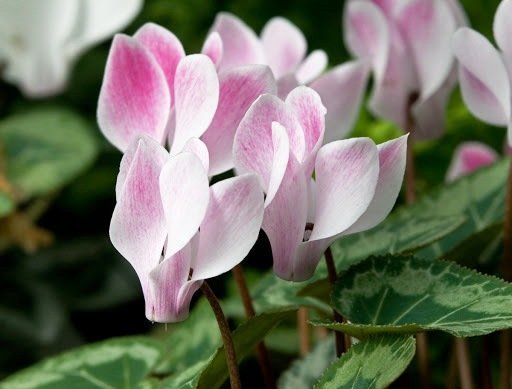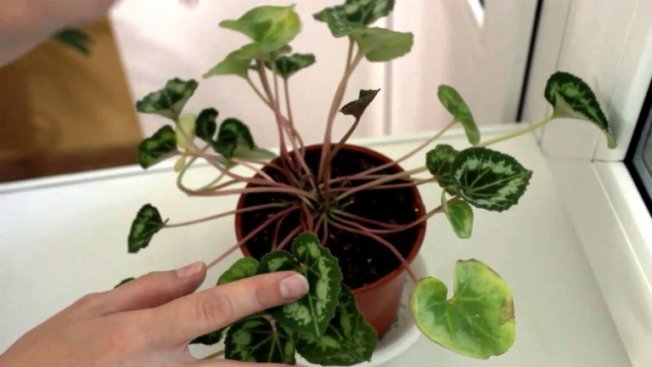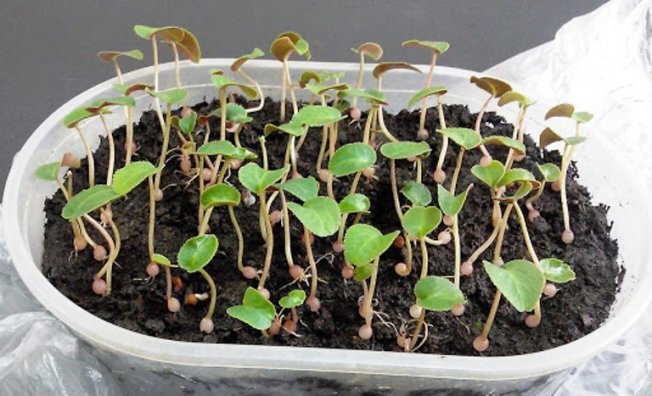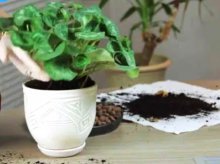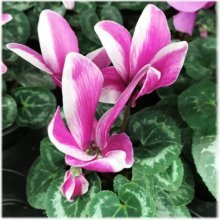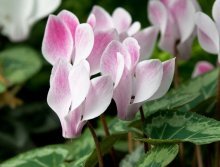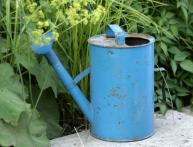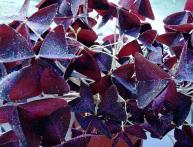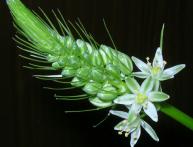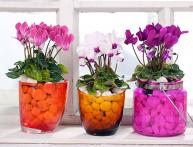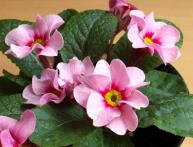Indoor cyclamen flower, characteristics, care, when and how to replant, propagation by seeds
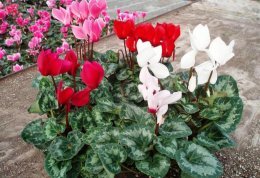
Most houseplants do not delight their owners with their colors in winter.
But the indoor cyclamen flower is not one of their ranks and, in the middle of a harsh winter outside the window, it may well give people the joy of seeing colorful and delicate buds.
Content:
- Indoor cyclamen flower, description and photo
- Plant species
- The meaning of the flower that symbolizes
- Cyclamen care: watering, fertilizing, lighting
- When and how to replant, soil requirements
- Is a transplant necessary after purchase?
- Contents of Persian cyclamen during the dormant period
- Reproduction methods, growing from seeds
Indoor cyclamen flower, description and photo
Cyclamen (another name for dryweed) is a perennial herbaceous representative of the Primrose family native to North-Eastern Africa, the Mediterranean coast and Asia.
Depending on the place of distribution in the wild, it is divided into a number of species that equally hibernate under unfavorable environmental conditions.
This often misleads owners, who may mistake a dormant plant for a dead one and throw it away.
Other characteristic features include:
- In the wild, it prefers foothill regions with a mild climate and above-zero temperatures in winter;
- It does not grow higher than 30 cm in height.If the plant is young, it does not exceed 10 cm at all;
- The size, shape of leaves and buds depend on the variety and age;
- The average life expectancy is 30 years. With age, the crown of the tree tree becomes more luxuriant. At the same time, the number of shades increases while their sizes decrease.
When grown indoors, it produces especially lush flowering during the cold season. Bright, delicate buds and unusual foliage make cyclamen an ideal gift for the winter holidays.
Plant species
Among the variety of dryer species, it is difficult to single out the most beautiful or remarkable ones.
All of them are good in their own way, but the most common types include those listed in the table.
| Name | The main differences and features of the variety |
| Alpine | It differs from its fellow drakvas in the angle of its petals (90 degrees instead of the usual 180). At the same time, they are slightly twisted and resemble a propeller. The color range ranges from pale pink to carmine pink. Alpine is known for its delicate aroma, reminiscent of honey; |
| African | The homeland of these delicate plants is the eastern part of Africa. The foliage is silver-green, heart-shaped, growing directly from the tuber. The color of the buds can vary from deep pink to pale. The species is thermophilic, but tolerates heat as poorly as frost. |
| Greek | It is found in shaded, damp places on the coasts of Turkey, Rhodes, Cyprus and Crete. The foliage shape of the Greek species can be either heart-shaped or oval and dark green or grayish in color. The buds of this representative appear before the foliage. Typically colored light pink or carmine pink |
| European or blushing | Found in the center of Europe. It is distinguished by a flat tuber with one growing point. It differs from its fellows by its memorable, delicate smell. The foliage of the European drab is heart-shaped with a serrated edge, basal, silver-green above and violet-green below. Flowers with five oval petals (light pink, pale violet, purple), arranged singly on long stalks. Duration of flowering period: from spring to autumn |
| Cypriot | Found on the island of the same name, it prefers rocky soils shaded by trees or shrubs. A perennial that can reach 8-16 cm in height. The color of the buds is white or pale pink |
Colchis (Caucasian, Pontic or Abkhazian) | Cyclamen is notable for the fact that the flowers of this species appear simultaneously with the foliage. Dryakva buds are dark pink with a darker shade along the border |
| Kossky | Depending on the variety, the leaf color is green or dark silver. The shade of the petals also varies: pink, white, purple |
| Neapolitan | One of the most famous species in our country. Another name for this species is Ivy-leaved, which the plant received due to the characteristic shape of the leaf. So the plate is round in shape with noticeable notches along the edges. The shape of the bud resembles that of the European cyclamen, but the Neapolitan one has small horns at the base |
| Persian | It is found naturally in Africa, Western Europe and Asia. The plant tolerates moderately cool winters without stopping flowering. In fact, the buds do not disappear during almost the entire growing season, which lasts for four months. The foliage of the Persian species is distinguished by a dark green shade along the border and a marbled white vein pattern. The foliage shape is heart-shaped. The buds can vary in color, which range from white and pink to scarlet. |
Despite such diversity, all types are equally beautiful; it cannot be said that some of them are better and some are worse. Different in color and shape of foliage, they will look equally impressive for any gardener.
The meaning of the flower that symbolizes
Dryakva is noteworthy not only for gardeners, but also for magicians. So this plant symbolizes harmony in the house where it grows. According to signs, he protects family members who care for him. However, his grace does not extend to random guests at home.
This delicate plant is capable of generating a kind of protective field around itself within a radius of 5 m.
So, if a person is subjected to systematic negative influence, he simply needs to place a junkie in the house. This delicate flower will help minimize the negative impact of systematic stress or the envy of others.
At the same time, this little defender of good does not simply absorb or repel negative energy. By accepting it, he returns waves of positive energy to the house.
Energy constantly circulates around healthy and well-groomed bushes, which has a beneficial effect on all residents of the house where they grow. And the more attention is paid to this amulet, the stronger its protection.
Cyclamen care: watering, fertilizing, lighting
Like any other plant, drakva needs care.
In order for the flower to delight its owners with lush blooms, it is recommended not to forget about some points:
- Watering should be done through a tray, rather than pouring water under the root.During flowering, moisturizing should be frequent; after flowering, it is recommended to reduce the amount of moisture. It is important that the soil does not dry out completely and is always slightly moist;
- The flower prefers diffuse lighting; exposure to direct sunlight has a negative effect on its condition;
- Air humidity should be high. Without watering the tree at the root, you need to systematically spray it with warm water from a sprayer;
- Fertilizing - once a month from the moment of leaf germination until the budding period, it is recommended to apply complex fertilizing. After the completion of bud formation and before the end of the flowering period, it is necessary to change complex fertilizers to special products for feeding blooming indoor flowers.
By following these points and observing the rules of transplantation, you can provide yourself with the pleasure of admiring the lush and bright flowering in winter. It is enough to spend very little effort and time to get results.
Let's watch a useful video about the indoor cyclamen flower and its care:
When and how to replant, soil requirements
All types of dryer can be replanted only after they have flowered and entered the dormant stage.
Different species have their own characteristics of transplantation:
- The Persian needs repotting twice a year. So in late May-early June it is planted, lightly covered with soil. After the leaf rosette grows, the flower is replanted again so that a third of the tuber remains above the ground;
- European - transplantation should be carried out at the end of September;
- Purple - needs one transplant every four seasons. It should be carried out in the spring before the growth of greenery begins.
- When selecting a container for transplanting, it is important that it is slightly larger than the previous one. Before the actual event, the pot needs to be disinfected to get rid of possible problems.
You can buy soil for dryer at a specialized store or prepare it yourself. To do this, it is recommended to mix part of the rotted humus, high peat and leaf soil in equal proportions. Disinfect the resulting mixture by pouring a weak solution of potassium permanganate or calcining it in an oven.
After this, you can begin the actual transplantation. Having placed a layer of drainage at the bottom of the pot, fill the pot with soil, leaving a few centimeters to the edges.
Let's watch a video on how to properly replant a houseplant cyclamen:
Remove the tuber from the old container and, after checking the root for damage or dry parts, place the tuber in the center of the pot. Sprinkle soil on top, without covering the top of the root head.
When replanting, it is important not to damage the root, as the plant may then begin to hurt. It is recommended to complete the transplantation with abundant watering.
Is a transplant necessary after purchase?
Almost all purchased flowers need to be replanted, since they arrive in stores in special shipping soil, which is not suitable for long-term cultivation. Cyclamen is no exception.
After purchasing, it is recommended to carefully remove it from the container and clean the root from the soil. After this, immerse the tuber in warm water for half an hour.
Before planting in a new pot, it is recommended to partially remove the leaves, leaving only the young rosettes of the central part.
If, during the inspection, traces of fungus were noticed on the tubers, it is recommended to treat them with a weak solution of potassium permanganate.
Immediately after transplantation, it is recommended to place cyclamen in a cool place. If the foliage begins to dry out, do not panic; after the flower has settled in and regained its strength, it will sprout green sprouts again.
Contents of Persian cyclamen during the dormant period
Cyclamen also requires special care during the dormant period. Already by the beginning of spring, after the flowering period ends, the woody plant does not produce new flower stalks, and the old ones begin to dry out.
In order for this period to pass with maximum benefit for the plant, it is worth helping. There is no need to further trim the sprouts; you can only carefully unscrew the dry flower stalks in a clockwise direction.
Accordingly, it is recommended to reduce both the frequency of watering and the amount of fertilizing.
With the right approach to care during the dormant period, you can expect re-blooming by autumn.
Reproduction methods, growing from seeds
There are several methods for propagating cyclamen. This way you can plant a tuber by separating the daughter sprouts. But in some types of dryer, daughter shoots are not formed, so the tuber needs to be divided.
To separate the tuber, you need to dry it and use a clean, sharp knife to divide it into two parts. It is important not to forget to sprinkle the cut areas with activated carbon or ash.
The root halves must be planted in the substrate and watered. However, there should not be too much water. Excess moisture can lead to the formation of rot and subsequent death of seedlings.
Another way to propagate cyclamen is by seeds.
Moreover, it is better not to store the seeds for a long time, but to sow them immediately after the capsule cracks.Before planting directly, it is recommended to soak them in warm water for a day. Those that float up should be put aside; they will not sprout.
After soaking, the seeds must be sown in a layer of compost at a distance of two centimeters from each other. It is recommended to sprinkle the seeds with a 6 mm layer of sand.
It is recommended to place the container with seedlings in a dark, but not completely dark place. After the formation of small tubers, the seedlings can be planted in separate containers.
Seed germination should be expected on the 30-40th day from the moment of planting.
It is important to systematically moisten the soil, not allowing it to dry out, but also not being too zealous. After the first shoots form, it is recommended to move the container to a place with better lighting. However, direct sunlight should be avoided.
Cyclamens grown in this way will bloom in a year or a year and a half.
After transplanting young tubers into separate containers, it is recommended to care for them in the same way as adults.
Indoor cyclamen is a plant of amazing beauty that can delight lovers of indoor greenhouses in winter. A rather delicate, but not too whimsical plant, an ideal gift for a winter holiday.

